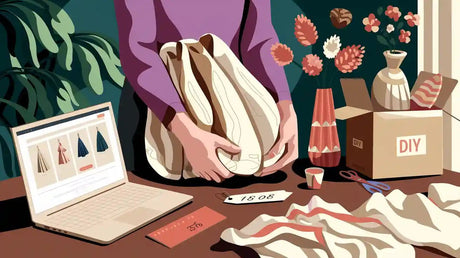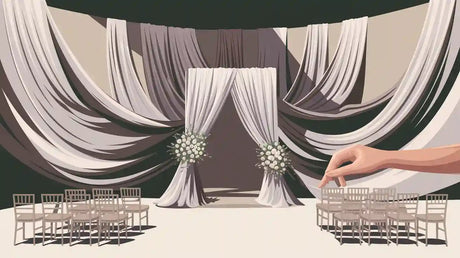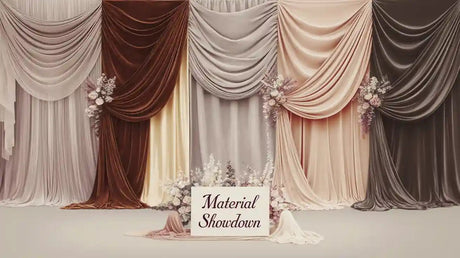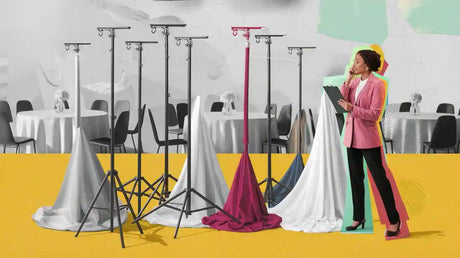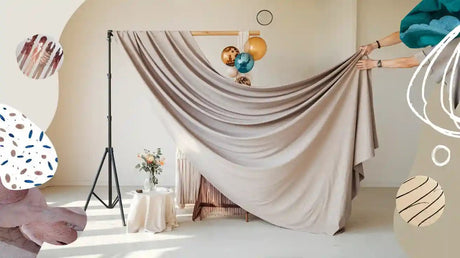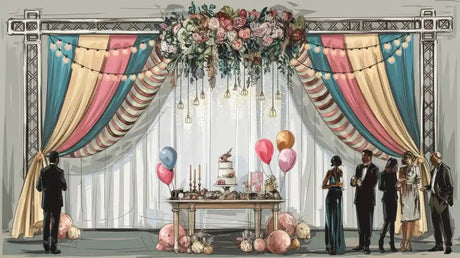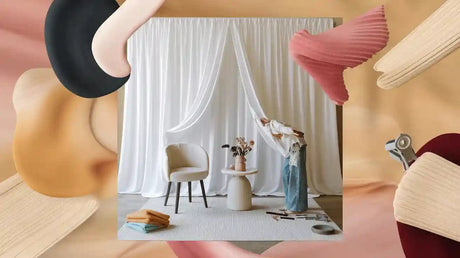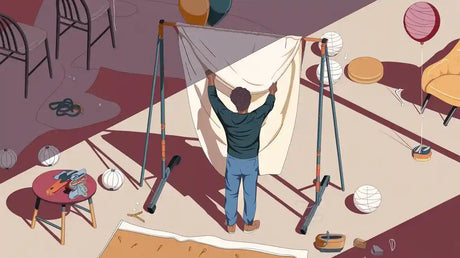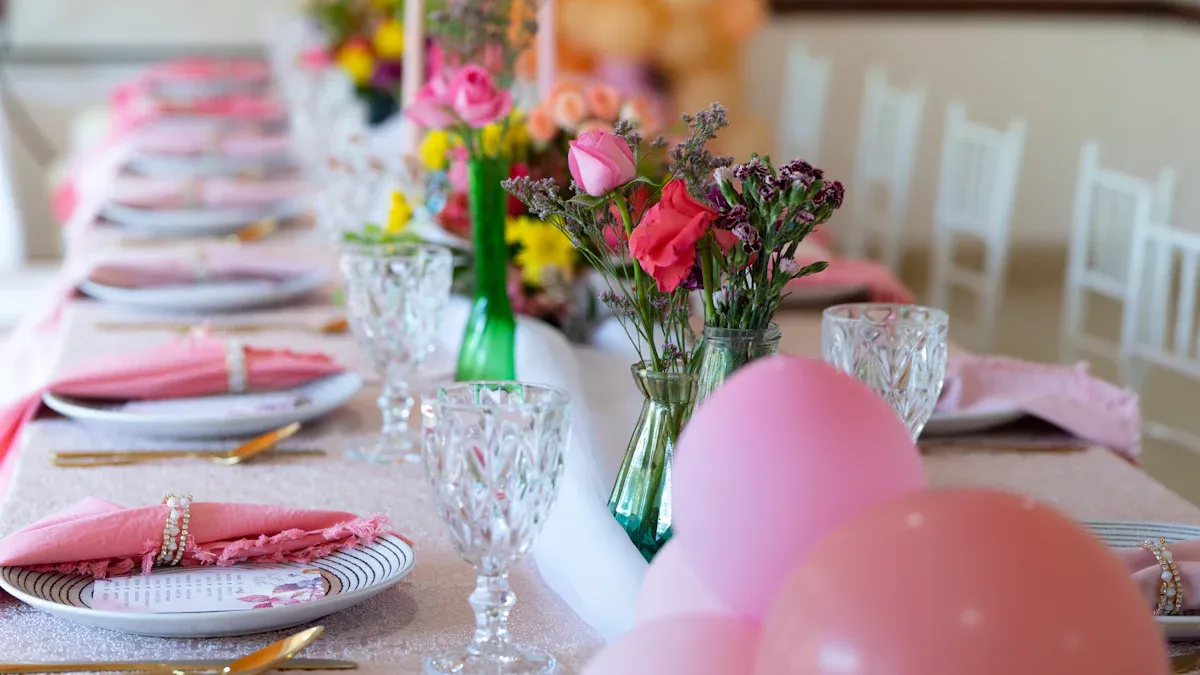
Imagine walking into an event and seeing a table covered with a bright, custom tablecloth showing a brand’s logo and colors. It quickly catches your eye, right? That’s the magic of custom tablecloths—they boost your branding and give a neat, professional look. Whether it’s a trade show, business event, or casual party, these tablecloths make your brand noticeable.
Customizing isn’t just popular; it’s a big deal. More businesses now use personal designs to show their style and connect with people. With smart design, good materials, and great printing, you can make tablecloths that look amazing and stay memorable. Your table isn’t just furniture—it’s a chance to show off your brand.
Key Takeaways
Custom tablecloths help people notice your brand at events. Add your logo and colors to show your brand clearly.
Pick colors carefully. Use opposite colors to make your logo pop and match your brand's style.
Make designs simple and tidy. Don’t add too much so your message stays clear and easy to read.
Choose strong materials like polyester that are easy to clean. Think about the event when picking the fabric.
Use the right printing method. Screen printing costs less for simple designs, while dye sublimation works well for detailed prints.
The Importance of Custom Tablecloths in Branding
How Custom Tablecloths Enhance Brand Visibility
Custom tablecloths are not just for decoration—they help advertise. Think of them as a big sign showing your logo or message. At events, these tablecloths grab attention and bring people to your booth.
A good tablecloth doesn’t just look nice; it sticks in people’s minds. When your setup looks professional, people remember your brand better. Using your brand colors and logo on the tablecloth makes everything match. This creates a strong and clear identity. Whether at a trade show or local event, these tablecloths make sure your brand gets noticed.
The Role of Logos in Custom Branded Table Covers
Your logo represents your brand, so put it on your tablecloth. A well-placed logo makes your table stand out and easy to spot. People can recognize your business quickly, even from far away.
But it’s not just about being seen. A logo on your tablecloth shows you care about details. This can make people trust your brand more. Whether you’re selling something or promoting a cause, your logo helps connect with others.
Key Objectives for Designing Custom Tablecloths
When making custom tablecloths, aim for something useful and attractive. Start by thinking about your brand. Use colors, fonts, and designs that show who you are.
Make sure your logo and text are easy to read from far away. Don’t add too many things to the design. Simple layouts often work best. Also, make your tablecloth flexible for different events. It should fit both formal and casual occasions. By following these tips, you’ll create a tablecloth that looks great and helps promote your brand.
Designing Custom Table Covers with Your Logo
Picking Colors That Match Your Brand
Using Opposite Colors for Better Attention
Colors are important for catching people’s eyes. When making custom table covers, use opposite colors to make your logo stand out. For example, bright text on a dark background is easy to see, even from far away. This makes your table noticeable at busy events.
Think about McDonald's red and yellow colors. These colors grab attention and make people feel excited or hungry. You can pick colors that match your brand’s style but still stand out with good contrast.
Matching Colors to Your Brand’s Style
The colors on your table cover should show your brand’s values. If your brand cares about nature, green shades can show eco-friendly ideas. Blue can give a calm and professional feeling. Orange often shows happiness and luxury.
Using color psychology helps you pick shades that connect with people. Keep your colors the same on all your marketing items. This makes your brand look organized and easy to remember.
Picking Fonts and Placing Text
Making Text Easy to Read
The font you use is very important. Choose bold, simple fonts that are easy to read from far away. Don’t use fancy fonts because they can be hard to understand.
Put your text in smart places. For example, keep your brand name or slogan at eye level. This way, people can quickly read your message as they walk by.
Keeping Text and Pictures Balanced
Too much text can confuse people. Use short phrases and balance them with pictures like logos or patterns. This keeps your design neat and clear.
Think of your table cover like a sign. If there’s too much text, it can hide your logo and other designs. A simple design looks better and works well.
Adding Logos the Right Way
Best Spots for Your Logo
Your logo is the most important part of your table cover. Put it in a spot where it’s easy to see, like the center or front of the tablecloth. This way, people notice your brand first when they come to your table.
If your tablecloth fits tightly, add the logo on more sides. This keeps your branding visible from all angles.
Choosing the Right Logo Size
The size of your logo matters. A tiny logo might not get noticed, but a huge one can look messy. Pick a size that fits the tablecloth and matches other designs like text or patterns.
A simple, well-sized logo is easier to see and remember. This makes your tablecloth look good and helps people notice your brand at events.
Keeping the Design Simple and Neat
Avoiding Busy Designs
When designing your custom tablecloth, keep it simple. Adding too many details can make it look messy. Focus on the basics like your logo, brand colors, and a short message. This makes your design clear and easy to understand.
Imagine someone walking by your table. They only have a few seconds to notice your setup. A crowded tablecloth can confuse them and hide important details. Use a simple design that shows your brand clearly. For example, avoid too much text or too many pictures. This keeps your tablecloth looking neat and professional.
Here’s a quick checklist for a clean design:
Design Tip |
Explanation |
|---|---|
Material |
Pick strong materials like polyester for a polished look. |
Colors |
Match colors to your brand for a unified appearance. |
Printing Quality |
Use clear printing to avoid blurry designs. |
Simplicity |
|
Logo Size and Placement |
Make sure your logo is easy to see and well-placed. |
Consistency |
Use the same colors and fonts to strengthen your brand. |
Graphics |
Add graphics that match your brand story for a lasting impact. |
Using Empty Space Smartly
Empty space, or the blank areas around your design, is very useful. It helps your tablecloth look neat and makes your logo stand out. Think of it as giving your design room to breathe.
For example, if your logo is in the center, leave space around it. Don’t fill every part of the tablecloth with text or pictures. Empty space creates balance and makes your design more attractive. It also helps people focus on the most important parts.
Here are some tips for using empty space:
Place your logo where it’s easy to see.
Keep text short to avoid clutter.
Use your brand colors to create a matching look.
By keeping your design simple and using empty space well, your tablecloth will look great and leave a strong impression.
Picking the Best Materials for Custom Tablecloths
Choosing the right material is as important as the design. The material affects how your tablecloth looks, lasts, and works. Let’s check out some common materials and how to pick the best one.
Common Material Options
Polyester: Strong and Easy to Clean
Polyester is popular because it’s strong and simple to maintain. It doesn’t wrinkle or stain easily, making it great for events. You can wash it in a machine, and it stays fresh. Plus, it keeps colors bright, so your logo looks good for a long time.
Cotton: Classic and Fancy Look
Cotton gives a timeless and classy feel. It’s soft, breathable, and looks polished on tables. Cotton is perfect for formal events like meetings or fancy parties. But it needs more care, like ironing, to stay neat.
Things to Think About When Picking Materials
Strength and Lasting Power
You want tablecloths that last through many uses. Polyester and cotton are strong and durable. Here’s a quick look at how materials perform:
Feature |
Details |
|---|---|
Strength |
Polyester and cotton are strong and last a long time. |
Easy Cleaning |
Stain-resistant or washable fabrics are easier to maintain. |
Popular Choices |
People pick materials based on trends, culture, and seasons. |
Cleaning and Care
Think about how much cleaning effort you want. Polyester is easy to clean and resists stains. Cotton needs more care to stay sharp. For heavy use, polyester blends are a smart pick. They’re tough and easy to clean with mild soap and cold water.
Matching Materials to Events
Indoor vs. Outdoor Use
The event type matters when picking materials. For outdoor events, choose something strong like polyester. It handles wind, spills, and light rain. For indoor events, cotton or linen adds a fancy touch.
Fancy vs. Casual Events
Formal events need polished materials like cotton or linen. These fabrics make your table look professional. For casual events, polyester or water-resistant fabrics work well. They’re practical, easy to clean, and still look nice.
Here’s a chart showing what materials people prefer:
By knowing each material’s strengths and matching them to your event, you can create tablecloths that look great and work well.
Printing Methods for Custom Branded Table Covers
Picking the right printing method is very important. It makes sure your logo and design look clear and professional. Let’s look at common printing methods and how to choose the best one.
Overview of Common Printing Techniques
Screen Printing for Simple and Budget-Friendly Designs
Screen printing is a popular and affordable option. It works well for simple designs with solid colors. This method uses stencils to press ink onto fabric, creating bold results. If your design has a basic logo or short text, screen printing is a smart choice. It’s also great for large orders, saving money for big events.
Dye Sublimation for Bright and Detailed Prints
Dye sublimation creates high-quality and colorful prints. It uses heat to transfer dye into the fabric, making designs last longer. This method is perfect for detailed logos or designs with many colors. The colors stay bright even after washing. If you want your table covers to stand out, dye sublimation is the best choice.
Comparing Printing Methods
Strength and Color Quality
Both methods give great results but work best for different needs. Screen printing is good for simple designs with bold colors. Dye sublimation is better for detailed designs and long-lasting prints. Its colors don’t fade easily, making it ideal for long-term use.
Printing Method |
Strengths |
Best For |
|---|---|---|
Screen Printing |
Affordable, bold colors, good for large orders. |
Simple designs with solid colors. |
Dye Sublimation |
High-quality, durable, works for detailed designs. |
Complex designs with bright colors. |
Cost and Speed
Screen printing is cheaper and faster for basic designs. It’s a good choice if you’re on a budget or need quick results. Dye sublimation costs more but gives premium quality. For the best details and colors, it’s worth the extra cost.
Tips for Working with Printing Experts
Use High-Quality Logo Files
Always send clear, high-resolution files of your logo. This ensures your design looks sharp and neat. Low-quality images can make prints blurry, which hurts your brand.
Check Proofs Before Printing
Ask to see a sample of your design before printing. This helps you spot mistakes and make changes. Checking proofs can save you from costly errors.
Pro Tip: Ask for fabric samples to check the material quality. This ensures the final product meets your standards.
By picking the right printing method and working with experts, you can create table covers that show off your brand perfectly.
Practical Tips for Functional and Stylish Tablecloths
Making Sure Your Tablecloth Fits Well
Measuring Your Table Correctly
To get the right fit, measure your table carefully. Use a tape measure to check the length, width, and height. For round tables, measure across the middle for the diameter. Write these numbers down so you don’t forget. A tablecloth that fits well looks neat and helps avoid tripping accidents.
Pro Tip: Add a few extra inches if you want the edges to drape nicely.
Picking Between Tight or Loose Styles
Decide if you want a tight or loose tablecloth. Tight ones fit snugly and look modern. They’re great for formal events or windy outdoor spaces. Loose ones are more relaxed and easy to adjust. These work better for casual events or when covering different table sizes.
Adding Useful and Stylish Features
Using Wrinkle-Free and Stain-Resistant Fabrics
Wrinkle-free fabrics like polyester save time and effort. They keep your tablecloth smooth during the event. Stain-resistant materials are also helpful, especially for food events. Spills can be wiped off quickly, keeping your table clean and tidy.
Fabric Type |
Benefits |
Best For |
|---|---|---|
Polyester |
Wrinkle-free, strong, affordable |
Trade shows, indoor events, food demos |
Spandex |
Stretchy, fancy, fire-safe |
Fancy events, easy care |
Canvas |
Tough, good for all weather |
Outdoor events, heavy use |
Adding Patterns or Textures for Style
Make your tablecloth unique with patterns or textures. A simple geometric design can make it stand out without being too much. Textured fabrics like jacquard or embossed polyester add a classy touch. These details make your tablecloth both useful and stylish.
Caring for and Storing Tablecloths
Folding and Storing the Right Way
Fold your tablecloths neatly to avoid wrinkles. For tight-fitting ones, fold along the seams to keep their shape. Store them in a cool, dry spot to stop mildew or fading. Use storage bags or boxes to protect them from dust and damage.
Tip: Label storage boxes by event type or table size for easy finding.
Cleaning Tips to Keep Them Looking New
Follow the cleaning instructions to make your tablecloths last longer. Wash with cold water and mild soap to protect the fabric. Clean small stains right away so they don’t set in. Avoid strong chemicals like bleach, which can ruin the fabric and design.
Care Tip |
Details |
|---|---|
Washing |
Use cold water to keep fabric strong. |
Detergent |
Choose gentle soap to avoid damage. |
Spot Cleaning |
Clean small stains fast to keep the tablecloth fresh. |
Regular Checks |
Look for damage and fix it quickly to stay professional. |
By following these steps, your custom tablecloths will stay in great shape and ready for any event.
Making unique tablecloths involves three main steps. First, design carefully. Second, pick the right materials. Third, choose a good printing method. These steps help your tablecloths look great and show off your brand. For example, using materials from places like India or China can save money. Modern manufacturing also makes production faster and improves quality.
Your tablecloth should match your brand to make it memorable. Use colors, logos, and fonts that show your brand’s style. A good design makes your booth look professional and welcoming.
Excited to begin? Start creating your custom tablecloths now or ask an expert for help. Let your brand stand out at every event!
FAQ
What size should my custom tablecloth be?
Measure your table’s length, width, and height carefully. Add a few extra inches for a nice drape. For round tables, measure across the middle to find the diameter. Use these numbers to pick a size that fits tightly or loosely, based on what you like.
Can I wash my custom tablecloth in a machine?
Yes, most polyester tablecloths can go in the washing machine. Use cold water and gentle soap to protect the fabric and design. For cotton or delicate fabrics, check the care label for special cleaning instructions.
How do I make sure my logo looks clear on the tablecloth?
Send a high-quality logo file to your printer. Vector files like .AI or .EPS are the best choice. These files keep your logo sharp and clear, even when it’s made bigger.
Which printing method works best for detailed designs?
Dye sublimation is great for detailed designs. It creates bright, long-lasting prints with accurate colors. If your design has lots of colors or small details, this method gives the best results.
How can I store my tablecloths safely?
Fold your tablecloths neatly along the seams. Store them in a cool, dry spot to avoid damage. Use bags or boxes to keep them safe from dust and moisture. Label the containers to find them easily later.
Pro Tip: Always clean your tablecloths before storing them. This stops stains from setting over time.

